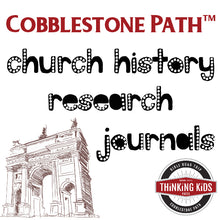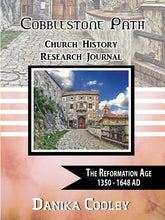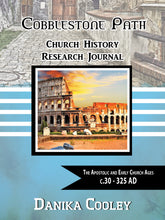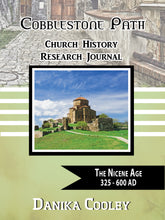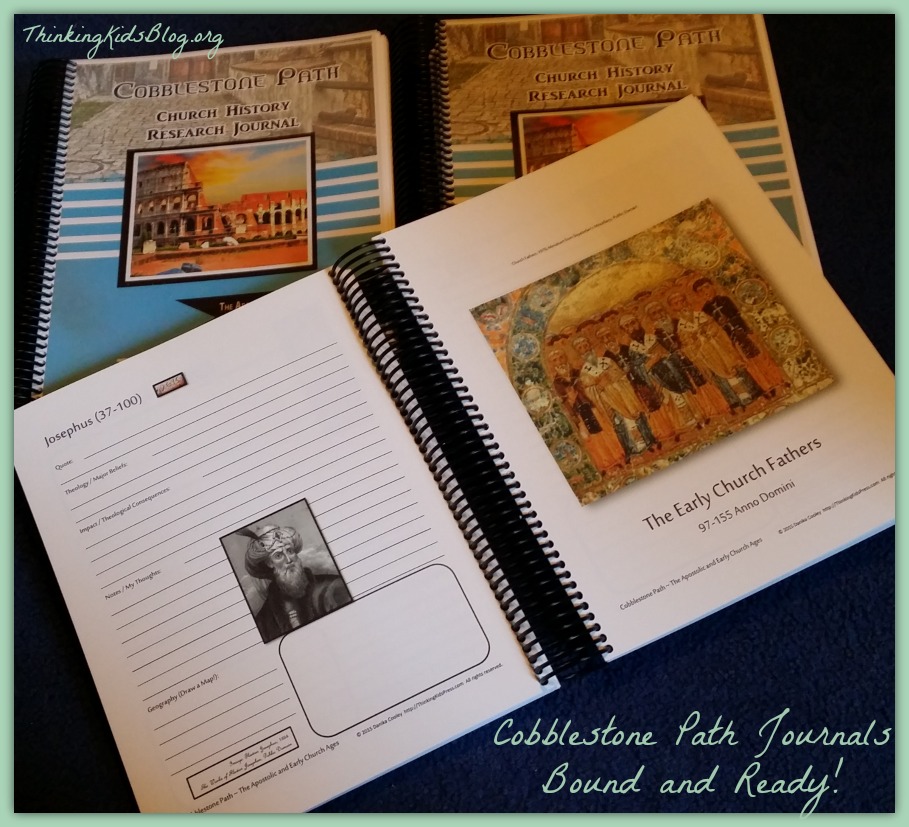Cobblestone Path™ Church History Journals
Regular price
$30.00
Sale
What is a Notebooking Journal?
This product is a digital PDF download.
A notebooking journal is a way for students to record their thoughts, narrate the information they’ve learned, reinforce important facts and ideas, and to illustrate their work. Notebooking journals are often open-ended, with much freedom given to record thoughts. Cobblestone Path™ notebooking journals provide a good deal of structure, giving students topics to research and specific information to seek out such as: dates, location, quotes, theological impact, purpose, participants, and surrounding events. The structure is meant to help young people grasp the important points of the subject of each notebooking page.
What skills does notebooking develop?
Notebooking provides the opportunity to develop skills in the areas of handwriting, pre-writing ~ notetaking and organization, reading comprehension, and research. Additionally, the Cobblestone Path™ research journals are designed to help students develop a strong understanding of the history of Christianity (and the heresies and controversies that plagued the Church), and to give students exposure to thousands of pieces of classic fine art throughout the series.

Check out When Lightning Struck!: The Story of Martin Luther
& download your FREE discussion guide or a 12-week unit study on Martin Luther FREE!
What’s the point of studying Christian history?
A strong understanding of Christian/Church history will help students develop a basis for history, worldview, philosophy, and theology. It will enable them to identify aspects of false teaching and truth in the world around them. For those in the faith, Church history is family history. We need to know where we came from, why we do what we do, and how we got to where we are.
For more on this subject, feel free to see what scholars and theologians have to say about the issue:
- 5 Reasons to Study Church History ~ Daniel Delgado, M.Div. Student at Western Seminary
- Why Study Church History? ~ A collection of quotes from Christians through time, compiled by Christian History Institute
- Seven Reasons to Study the Church’s Past ~ Tim Challies of Challies.com
- Top Ten Reasons to Read Christian History ~ Chris Armstrong, Christian History Magazine
- 7 Ways Christian History Benefits You ~ Chad Smethhurst, Associate Editor for the Gospel Coalition at Christianity.com
How is Cobblestone Path™ used?
Each of the eight Cobblestone Path™ Church History Research Journals is a chronological series of structured notebooking pages. Each journal (or “age”) is divided into three eras to help students orient the events in time.
The pages included cover:
- Timelines
- Important vocabulary
- A division of each age into three eras
- Major figures
- Minor figures
- Important events
- People groups (usually sects or heretical groups)
- Important documents
- Minor documents (or those for which there is little surviving evidence).
Students will use the structured pages to guide their research and to help determine what portions of their reading are important for future information. The journals will give students a visual and written history of the Christian Church, pulled from a variety of resources.
Who is it for?
Cobblestone Path™ is for middle and high school students. While the notebooking involved may be complex for a young 6th grader, the practice of researching and notetaking with parental guidance will quickly help a student progress to independent study. The most important pages are marked with a sign at the top:

Thus, students will be able to self-identify pages that should be filled out for the most basic comprehension level, giving parents a way to ease the workload for middle school if so desired.
How do I schedule Cobblestone Path™?
I suggest using the Cobblestone Path™ Church History Research Journals independently from the history curriculum of your choice. Fairly equal weight is given to each Church history “age” in the journals, while this is not generally true in most history programs. For instance, our family uses a four year history cycle. Were we to attempt to sync Cobblestone Path with our history program, we would need to do 1 1/2 journals the first year, 5 1/2 journals the second year, and one journal each of the last two years. Instead, we will work through the journals consecutively for six years.
Each journal has approximately 250-300 pages of material. Using the journals for six years (36 weeks/year) for four days each week, a student will need to complete two to three pages per day of the notebooking. Over a seven year course, students would need to do about a page or two a day (at least half the days would need to be two pages). These calculations are based on 300 pages/journal, with all pages completed. That gives you a lot of cushion. If you are only doing the pages marked with the

you will only need to do one to two pages per week. The program is designed to be flexible to meet the needs of your school or family.
What resources should we use?
I will publish a list of recommended resources for each journal and link those lists here. I recommend choosing a good overview text, and then allowing students to use the internet to do additional research. There are sites dedicated, for example, to publishing and cataloguing the Early Church documents which will be helpful as students research.
Because research is one of the objectives of the program, I will not provide an exhaustive list of websites, though I may link to several important resources for each journal. Please be certain that you have placed an appropriate filter on your internet and that you are nearby while your students search.
Each notebooking journal has a resource list to supplement and provide opportunity for further research into the period.
Cobblestone Path™ ~ The Apostolic and Early Church Ages ~ c.30-325 AD ~ Resource List
Cobblestone Path™~ The Nicene Age ~ 325-600 AD ~ Resource List
Cobblestone Path™ ~ The Dark Age ~ 600-950 AD ~ Resource List
Cobblestone Path™ ~ The Medieval Age ~ 950-1350 AD ~ Resource List
Cobblestone Path™ ~ The Reformation Age ~ 1350-1648 AD ~ Resource List
Cobblestone Path™~ The Rational Age ~ 1648-1790 AD ~ Resource List
Cobblestone Path™ ~ The Revival & Missions Age ~ 1790-1914 AD ~ Resource List
Cobblestone Path™ ~ The Postmodern Age ~ 1914 AD – Present~ Resource List
What will each journal cover?
Each journal covers a period of time (or “age”) in Church History. There’s no clear agreement on the divisions of Church ages, so I have divided these ages thematically and have tried to name them appropriately.
Cobblestone Path™ is designed to look at the major aspects of each age from a global view. Students will find people and movements that stood in opposition to the Christian Church, as well as those who claimed the name of Christ, yet espoused a different gospel.
This research journal series is compiled from a Protestant viewpoint. There is not a complete list of the bishops and popes of Rome or of world leaders, however, at every point where the individual popes or world leaders are important to understanding Church history, they are included. Below are the titles and periods covered by each journal.
- Cobblestone Path™: The Apostolic and Early Church Ages (c.30-325 AD)
- Cobblestone Path™: The Nicene Age (c.325-600 AD)
- Cobblestone Path™: The Dark Age (c.600-900 AD) [Not yet published]
- Cobblestone Path™: The Medieval Age (c.900-1350 AD) [Not yet published]
- Cobblestone Path™: The Reformation Age (c.1350-1648 AD)
- Cobblestone Path™: The Rational Age (c.1648-1790 AD) [Not yet published]
- Cobblestone Path™: The Revival and Missions Age (c.1790-1914 AD) [Not yet published]
- Cobblestone Path™: The Modern Age (c.1914 AD - Present) [Not yet published]
What about the artwork?
Each Cobblestone Path™ journal contains many photographs and fine art reproductions, totaling thousands of art pieces for the series. Every piece of art has been carefully chosen with an eye for modesty and appropriateness. There are no purposeful representations of angels, demons, Theophanies, or the appearance of Jesus Christ. (I say purposeful because sometimes the little cupids in illuminations can be difficult to spot. I have done my best to survey the artwork with an eye for the supernatural.)
This is in respect to those who view such work as a violation of the Second Commandment. As such, some artwork has been cropped, which will be noted by the use of the term “(Detail)” following the title or description of the piece.
All work is either in the public domain, or released for use by Creative Commons licenses.
How do I count high school credits?
You can calculate high school history or elective credits based on the amount of time your student spends on Cobblestone Path. Two articles to help you determine the credits based on the speed at which your students use the journals:
- Evaluation of High School Credits ~ HSLDA
- Homeschooler’s Guide to High School Credits ~ Let’s Homeschool High School
It’s a digital file, but I need a physical copy for my student to write on. How should I produce that?
My suggestion is to print the research journals double-sided (duplexed) with the turn on the long side. I like to print in full-color on “Best Quality” to allow my students to fully appreciate the fine art. My middle school children enjoy writing in pen, and to allow for double-sided full-color printing with pen as the writing implement, I prefer to print on 65lb white cardstock. This prevents much bleed-through from the other side.
I like to take my copies to the local copy center (FedEx for me) and have them spiral-bound with a clear plastic front and hard plastic back. I appreciate the solid quality of the bound notebook, it’s easy to open and write on, and compact for storage. The journals printed and bound in this manner take on a permanent, heirloom quality. That said, you can always print the notebooking pages single-sided, 3-hole punch them and put them into a regular 3-hole binder.
What is the copyright license?
Cobblestone Path™ Church History Research Journals come with a family/household license. This means that one purchase can be reprinted for every child in a family. In fact, I will be completing the journals alongside my children, so I made myself a copy as well. That is also allowed. Sharing between families, electronic redistribution, and/or reselling are not allowed. (Actually, it is illegal according to copyright law.) The price has been set to allow for the cost of binding and printing which your family will incur, and the household (rather than individual) license is a gift from me.
For classrooms or co-ops, a license is available for each journal for the entire classroom.
We absolutely loved using this journal as part of our History studies. Not only did it save me a lot of time when planning, but it guided my high schooler gently through the dawn of the Early Church. We both learned valuable information that made a lasting impact. Notebooking through history can certainly be overwhelming, but these ready-made journals provide an excellent framework. I hope that the rest of the journals will be released in the future and that my younger child will use the complete set when in high school.




